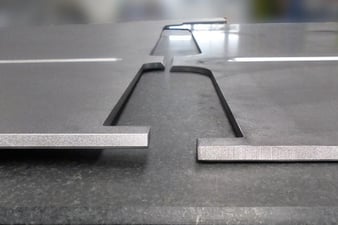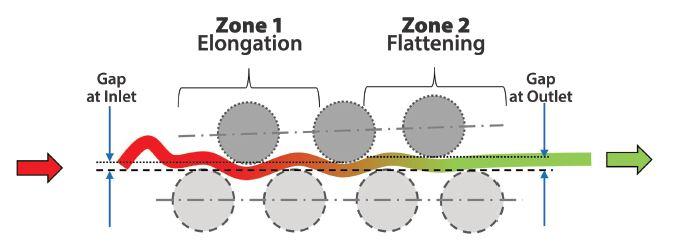We are pleased to share that Dane Manufacturing has been listed once again in The Fabricator's Fab 40 for 2023.
The Importance of Part Leveling
The sheet metal and plate that gets delivered to a metal fabricating company looks flat enough. But looks can be deceiving, and that is especially true with metal. What might seem flat at first is likely to lose its flatness during fabricating.

This makes sense when you consider what happens to the raw material before it’s delivered to the shop. Sheets and plates come from the mills in coils. In metal service centers, these coils are uncoiled, straightened, and finally cut to length. Although the sheets appear to be flat, they still have stress inside. (The stress is evident in the material’s grain.)
When these materials are cut using a thermal power source, such as a laser or plasma cutting machine, the stress is released, and the results are obvious. Parts become uneven. This goes for both thin and thick metal parts.
This also goes for both ferrous and nonferrous parts. The use of the assist gas during cutting actually plays a large part in this process. For example, when oxygen is used for cutting carbon steel, the oxygen reacts with the metal in an exothermic reaction. That introduces a great amount of heat to the cutting zone, which allows the cutting process to occur rapidly. (The byproduct of this chemical reaction is an oxidized edge, which needs to be cleaned to allow for paint adhesion.) The additional heat, however, also releases more stress in the metal. Cutting with nitrogen, an inert gas, reduces the heat input when compared to oxygen, but even with the gentler process, stresses are still being released.
This can become particularly troublesome for the fab shop with new laser cutting technology because some parts may tilt on the slats after being laser-cut and become an obstacle for the cutting head, especially when cutting speeds reach 30 m/min. or more and acceleration of more than 2 m/s² has become the standard. A very expensive piece of fabricating technology runs the risk of being wrecked by an uneven part on the cutting bed.
Any blanking process is able to release stress first introduced during coiling. That stress probably is most evident in the metal’s springback after the cutting or punching is done. (Punching works the material to the point that additional stress is released in material. This can be seen on the newly perforated parts, for instance.)
Combating the Material Stresses
What are metal fabricators to do to combat the stresses introduced during coiling and released after the parts have been cut or punched? This is where a part leveling machine can help. It can deliver flat parts for applications in which it is absolutely necessary for downstream fabricating processes to receive leveled parts to help ensure higher productivity and fewer rejects during bending and welding.
A part leveling machine delivers flatness through a series of rollers that apply pressure to the sheet metal or plate part. The rollers work the material as it makes its way through the machine. The intensity of the pressure applied to the material reduces and eventually eliminates the stresses that are introduced at the metal service center.

How are those rollers organized? That depends on the material, the material thickness, and the desired specifications. The variables of a part leveling machine include:
- The number of rollers.
- How the rollers are spaced in the machine.
- How the rollers are arranged and supported.
- Stiffness of the roller frames and the entire machine.
- Support of rollers (supported length, arrangement of rollers).
- A gap control system and its ability to keep the gap stable.
- Electrical power consumption efficiency.
- Ease of cleaning leveling and supporting rollers and of maintaining the machine.
The leveling process can deliver a high degree of precision, but it really depends on the application and on the thickness and type of material. For example, a leveling machine can deliver flatness of 0.5 mm/m to 1 mm/m for parts destined for cranes and mining equipment and that would be considered very good. That flatness, however, would not work for a manufacturer of saw blades, which require 0.1 mm/m or better. Fortunately, the same part leveling machine that delivers acceptable parts for the heavy equipment manufacturer can produce even more high-toleranced parts for the saw blade manufacturer.
By elongating the metal, the machine’s rollers destress and flatten the parts.
As it relates to the size of parts to be leveled, it all depends on the roller diameter. Each roller diameter in combination with spacing of the rollers and the design of the roller frame, supporting roller, and the machine frame has its specific window of operations. In general, small roller diameters are used for thin material, and bigger rollers are used for thicker material. Leveling machines typically can flatten parts from 0.2 mm to almost 70 mm.
Reaping the Benefits
Part leveling can help metal fabricators increase output and productivity. Reports from metal fabricating companies that incorporate a part leveling machine into their operations indicate that after leveling parts, they are about 25% more productive in their bending operations. The leveled parts bend up more accurately, which means less rework and more consistency. In the welding department, that translates into parts that fit into simple jigs and have consistent gaps. Welders are happy. Fewer rejects are the result, and productivity is increased. This is especially true with robotic welding. The tighter and more consistent gaps result in less filler wire being used, smoother seam lines, and a faster automated process.
This article was originally published by The Fabricator in August 2021. For more information, visit www.thefabricator.com. The original article can be found here.
ABOUT THE AUTHOR
Dr. Hans-Peter Laubscher
Managing Director
Wintersteiger, Metal Division/Kohler Maschinebau GmbH
